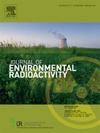Evaluation of the sample preparation method for environmental reference matrices suitable for organically-bound tritium interlaboratory comparison exercises
IF 2.1
3区 环境科学与生态学
Q3 ENVIRONMENTAL SCIENCES
引用次数: 0
Abstract
The measurements for tritium in the environmental samples are usually related to the tissue-free water tritium (TFWT). Research studies for the complex behavior of tritium were performed over the years due to the increased probability of elevated tritium concentrations to be released in the environment. Laboratory methods that enable to accurately determine the various forms of tritium, including organically-bound tritium (OBT) were developed and validated through inter-laboratory comparison (ILC) exercises, by the Environmental Control Laboratory of the Cernavoda Nuclear Power Plant (NPP) from Romania. Furthermore, sample preparation methods for OBT determinations were evaluated to develop different types of reference materials of environmental samples to be tested through ILC exercises. This paper describes the international Organically-Bound Tritium (OBT) intercomparison exercise, organized by the Cernavoda Nuclear Power Plant (NPP) in 2024–2025, using fruit sample (grapes) from Cernavoda town and the result evaluation for the participating laboratories performed using robust analysis (Algorithm A) method described in the ISO 13528:2022 standard. The results obtained are encouraging as most of the participating laboratories did not change the observed dispersion of the results for activity concentration level around 80 Bq/L of combustion water, although they performed different methods for sample preparation and different measurement systems for tritium counting.
适合于有机结合氚实验室间比较练习的环境参考基质样品制备方法的评价
环境样品中氚的测量通常与无组织水氚(TFWT)有关。多年来,由于氚浓度升高释放到环境中的可能性增加,对氚的复杂行为进行了研究。罗马尼亚切尔纳沃达核电站(NPP)环境控制实验室开发并通过实验室间比较(ILC)演习验证了能够准确确定各种形式氚(包括有机结合氚(OBT))的实验室方法。此外,还评估了用于OBT测定的样品制备方法,以开发通过ILC练习测试的环境样品的不同类型的标准物质。本文描述了由切尔纳沃达核电站(NPP)于2024-2025年组织的国际有机结合氚(OBT)相互比较演习,使用来自切尔纳沃达镇的水果样本(葡萄),并使用ISO 13528:2022标准中描述的稳健分析(算法A)方法对参与实验室进行结果评估。虽然采用了不同的样品制备方法和不同的氚计数测量系统,但大多数参与实验室在燃烧水的活度浓度水平为80 Bq/L左右时,并没有改变观察到的结果分散,结果令人鼓舞。
本文章由计算机程序翻译,如有差异,请以英文原文为准。
求助全文
约1分钟内获得全文
求助全文
来源期刊

Journal of environmental radioactivity
环境科学-环境科学
CiteScore
4.70
自引率
13.00%
发文量
209
审稿时长
73 days
期刊介绍:
The Journal of Environmental Radioactivity provides a coherent international forum for publication of original research or review papers on any aspect of the occurrence of radioactivity in natural systems.
Relevant subject areas range from applications of environmental radionuclides as mechanistic or timescale tracers of natural processes to assessments of the radioecological or radiological effects of ambient radioactivity. Papers deal with naturally occurring nuclides or with those created and released by man through nuclear weapons manufacture and testing, energy production, fuel-cycle technology, etc. Reports on radioactivity in the oceans, sediments, rivers, lakes, groundwaters, soils, atmosphere and all divisions of the biosphere are welcomed, but these should not simply be of a monitoring nature unless the data are particularly innovative.
 求助内容:
求助内容: 应助结果提醒方式:
应助结果提醒方式:


